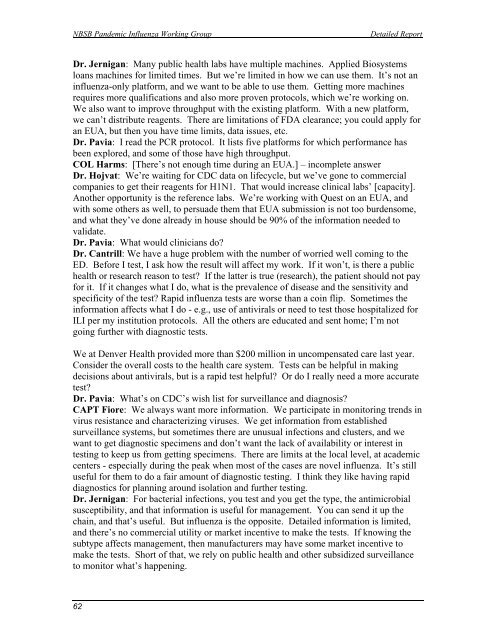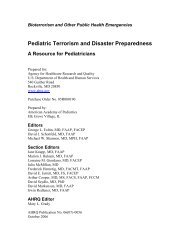H1N1 COUNTERMEASURES STRATEGY AND ... - PHE Home
H1N1 COUNTERMEASURES STRATEGY AND ... - PHE Home
H1N1 COUNTERMEASURES STRATEGY AND ... - PHE Home
Create successful ePaper yourself
Turn your PDF publications into a flip-book with our unique Google optimized e-Paper software.
NBSB Pandemic Influenza Working Group<br />
Detailed Report<br />
Dr. Jernigan: Many public health labs have multiple machines. Applied Biosystems<br />
loans machines for limited times. But we’re limited in how we can use them. It’s not an<br />
influenza-only platform, and we want to be able to use them. Getting more machines<br />
requires more qualifications and also more proven protocols, which we’re working on.<br />
We also want to improve throughput with the existing platform. With a new platform,<br />
we can’t distribute reagents. There are limitations of FDA clearance; you could apply for<br />
an EUA, but then you have time limits, data issues, etc.<br />
Dr. Pavia: I read the PCR protocol. It lists five platforms for which performance has<br />
been explored, and some of those have high throughput.<br />
COL Harms: [There’s not enough time during an EUA.] – incomplete answer<br />
Dr. Hojvat: We’re waiting for CDC data on lifecycle, but we’ve gone to commercial<br />
companies to get their reagents for <strong>H1N1</strong>. That would increase clinical labs’ [capacity].<br />
Another opportunity is the reference labs. We’re working with Quest on an EUA, and<br />
with some others as well, to persuade them that EUA submission is not too burdensome,<br />
and what they’ve done already in house should be 90% of the information needed to<br />
validate.<br />
Dr. Pavia: What would clinicians do?<br />
Dr. Cantrill: We have a huge problem with the number of worried well coming to the<br />
ED. Before I test, I ask how the result will affect my work. If it won’t, is there a public<br />
health or research reason to test? If the latter is true (research), the patient should not pay<br />
for it. If it changes what I do, what is the prevalence of disease and the sensitivity and<br />
specificity of the test? Rapid influenza tests are worse than a coin flip. Sometimes the<br />
information affects what I do - e.g., use of antivirals or need to test those hospitalized for<br />
ILI per my institution protocols. All the others are educated and sent home; I’m not<br />
going further with diagnostic tests.<br />
We at Denver Health provided more than $200 million in uncompensated care last year.<br />
Consider the overall costs to the health care system. Tests can be helpful in making<br />
decisions about antivirals, but is a rapid test helpful? Or do I really need a more accurate<br />
test?<br />
Dr. Pavia: What’s on CDC’s wish list for surveillance and diagnosis?<br />
CAPT Fiore: We always want more information. We participate in monitoring trends in<br />
virus resistance and characterizing viruses. We get information from established<br />
surveillance systems, but sometimes there are unusual infections and clusters, and we<br />
want to get diagnostic specimens and don’t want the lack of availability or interest in<br />
testing to keep us from getting specimens. There are limits at the local level, at academic<br />
centers - especially during the peak when most of the cases are novel influenza. It’s still<br />
useful for them to do a fair amount of diagnostic testing. I think they like having rapid<br />
diagnostics for planning around isolation and further testing.<br />
Dr. Jernigan: For bacterial infections, you test and you get the type, the antimicrobial<br />
susceptibility, and that information is useful for management. You can send it up the<br />
chain, and that’s useful. But influenza is the opposite. Detailed information is limited,<br />
and there’s no commercial utility or market incentive to make the tests. If knowing the<br />
subtype affects management, then manufacturers may have some market incentive to<br />
make the tests. Short of that, we rely on public health and other subsidized surveillance<br />
to monitor what’s happening.<br />
62
















